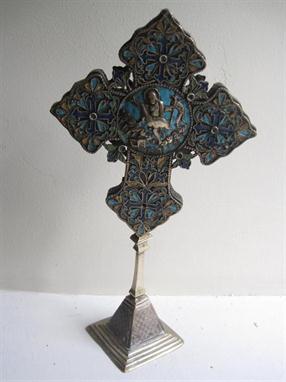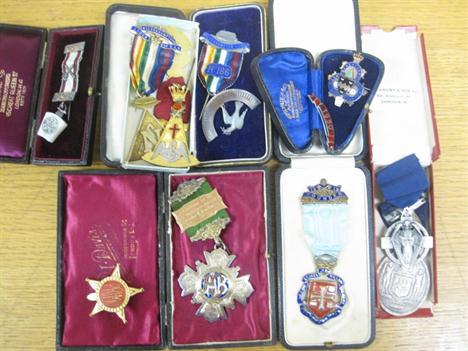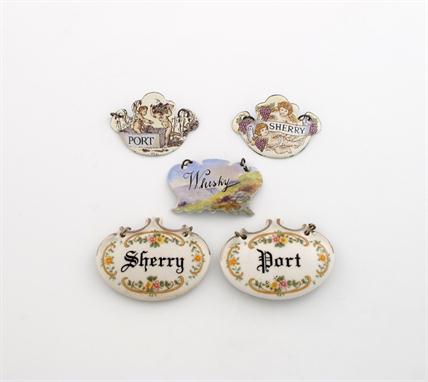charles Frodsham & Co, Paris, a small quarter striking Gorge carriage clock the eight-day duration movement having a platform lever escapement and striking the hours and quarters on two gongs with push button repeat, with a ‘strike/silent’ lever to the underside of the case, the backplate signed ‘Frodsham, 19797’, the white enamel dial with black Roman numerals, blued steel spade hands and signed ‘Charles Frodsham, & Co, Paris, 19797’, with a lacquered brass Gorge case, height 10.5cm (handle down) 12.5cm (handle up) * Charles Frodsham, born on the 15th of April 1810, was the son of William Frodsham, see lot 655, and was apprenticed to his father for seven years. In 1834 he set up his own business making precision timekeepers. In 1854 the firm was granted the Royal Warrant and made keeper of Her Majesty’s clocks. He acquired a number of prestigious clock making firms including that of J.R Arnold of 84, Strand.
396325 Preisdatenbank Los(e) gefunden, die Ihrer Suche entsprechen
396325 Lose gefunden, die zu Ihrer Suche passen. Abonnieren Sie die Preisdatenbank, um sofortigen Zugriff auf alle Dienstleistungen der Preisdatenbank zu haben.
Preisdatenbank abonnieren- Liste
- Galerie
-
396325 Los(e)/Seite
japy Freres, Paris, a pink marble and gilt-metal clock garniture the eight-day duration movement striking the hours and half-hours on a bell with an outside countwheel, the enamel dial with black Arabic numerals, decorative swags between and decorative brass hands, the marble case with four pillars and surmounted by an urn, with various gilt-metal mounts, standing on a shaped base, height 41cm. With matching two-piece side candelabra. * Originally set up in circa 1771 in Beaucourt by Georges Frederic Japy for the purpose of making ebauches (blanks) for watch movements, by 1809 they were also producing clock movement blanks. By 1810, Pierre’s sons Frederic-Guillaume, Louis-Frederic and Jean-Pierre had joined the firm and soon after the death of Frederic in 1812, his sons renamed the firm Japy Freres et Cie.
A 19th century perpetual calendar mantel clock the eight-day duration movement striking the hours and half-hours on a bell, stamped on the backplate ‘J.B.D’, with a visible Brocot escapement to the centre of the two-piece enamel dial, with black Roman numerals, a sweep seconds hand and blued steel moon hands, with a glazed panel below the dial through which is visible the Ellicott style compensating pendulum, with two thermometers set either side of the dial, each with white enamel dials and both signed ‘Paris 1838’, the left-hand side dial showing Reaumur, the right-hand side showing Fahrenheit, with a round barometer dial set to the lower right-hand side having two badges stamped on, one reading ‘E. Bourdon and Richards, Patent, Gold Medal, Paris Exhibition’, the other ‘Council Medal, Universal Exhibition, London, 1851’, and numbered ‘21849’ with a further dial to the left-hand lower having three subsidiary dials showing the moonphase, day and date, with the outer dial marked for the perpetual calendar changes and the month, the black and red marble case of Egyptian influence with pyramid style sides, height 45cms.
A Sitzendorf porcelain monkey band mantel clock the eight-day duration movement striking the hours and half-hours on a bell, the backplate stamped with the trademark for Japy Freres, the white enamel dial with black Roman numerals and blued steel spade hands, the case in the form of floral decoration surrounding a Monkey band, height 33cm. * For details of Japy Freres see lot no. 642.
tupman, London, an ormolu mantel clock the eight-day duration timepiece fusee movement, signed to the backplate ‘Baetens, London’, the white enamel dial with black Roman numerals, blued steel moon hands, and signed with the retailer’s name ‘Tupman, 44 Gt Russell, St’, the ormolu case with a classical winged female figure holding a cornucopia of flowers and leaning against the central block with raised decorative mounts, with a pillar to the other side having a nautical theme, the base with applied mounts and standing on turned feet, height: 34cm. * Various members of the Tupman family are recorded working in the early 19th century including William Tupman, apprenticed in 1806, the son of the clockmaker George, who was working from circa 1794, with the partnership of George & Henry recorded from circa 1844. They were both clockmakers and retailers. * Joseph Baetens is recorded as working in London circa 1832 specialising in bronze and ormolu clocks.
A pair and a trio of WWI General Service medals awarded to DVR.AR. Gillard, ASC (016950) together with his Royal Engineer Pair registered 3288 FPR.AR. Gillard RE medal, his dog tag, together with seven brass buttons, an enamel badge and three WWII memorial pamphlets including an In Memorian Order of Service for a ceromony held in Germany, June 1945, XX11 British Liberation Army with printed roll of honour and other related items.
A small collection of four cased sets of spoons, comprising silver examples: a set of six Norwegian silver-gilt and enamel spoons, by J. Tostrup, the terminals a with thistle shaped enamel decoration, plus a set of six Sandringham pattern teaspoons, another set of teaspoons and a set of six electroplated coffee bean end teaspoons., approx. weighable 5oz. (4)
A collection of silver boxes, various dates and makers, comprising: a George III snuff box, Birmingham 1816, one of oval form, scroll borders, the hinged cover set with a jasper ware panel, Chester 1905, plus a Victorian snuff box, Birmingham 1861, plus a silver and tortoiseshell box, a metalware box and a gilt metal and enamel box, approx. weight 4oz. (6)
A silver and enamel cigarette box, Birmingham 1929, square form, the hinged cover applied with an enamel badge of the Auto Cycle Union 1903, Western Centre, and inscribed `Cotswold Cup Trial, 1930, F. Brown 1st Class`, plus a silver and enamel match holder, Chester 1913, applied with the enamel badge of Coventry and Warwickshire Motor Club. (2)
The Royal Victorian Order, Commanders` Neck Badge, silver-gilt and enamel, numbered on reverse "1166", in fitted leather case of issue, by Collingwood; Elizabeth II, Coronation Medal, 1953; both extremely fine; WW I, War medal (21045 Pte. C. A. Birch. Manch. R.), water-stained on reverse, very fine. (3)
A mixed lot of silver and non silver scent bottles, comprising: five silver mounted scent bottles, including a modern Tiffany example, a late-Victorian scent bottle, of hinged form with a green glass liner, one by William Comyns, London 1906, a silver and enamel scent bottle and another, plus various non silver scent bottles and snuff bottles. (qty)
A small collection of seven ceramic and glass scent bottles, comprising: a silver mounted bottle decorated with a girl holding a bird, a red glass bottle in the Mary Gregory style with a scene of a child in a landscape, a green glass scent bottle, two modern glass scent bottle, two ceramic bottles and a cased set of three base metal and enamel mounted scent bottles. (7)
-
396325 Los(e)/Seite












































